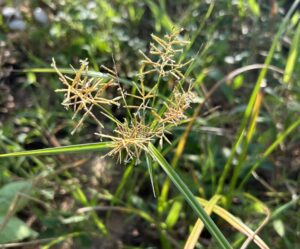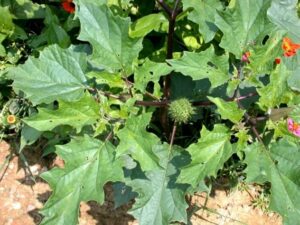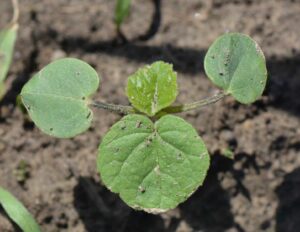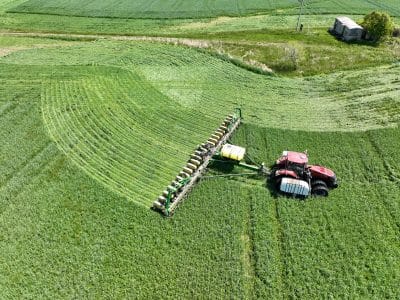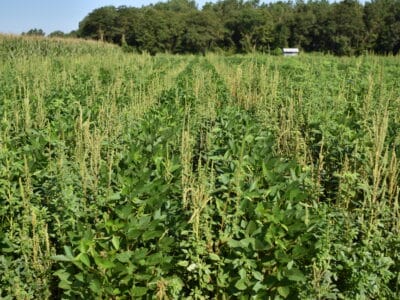Echinochloa crus-galli (L.) P. Beauv.
Also known as cockspur grass, barnyard millet, watergrass, chicken panic grass, cocksfoot panicum, wild millet

Biology
Barnyardgrass is a summer annual grass species in the Poaceae family. It is a globally successful weed due to its prolific seed production, seed dormancy, ability to grow rapidly in a broad range of climates, and its ability to flower throughout the growing season. It also grows well in wet soils.
Where is barnyardgrass a problem?
Barnyardgrass is a widespread and common weed species in agronomic crops, given that it thrives in temperate and tropical regions. It is reported as a weed in 36 different crops in 69 countries. It can be found invading grain crops, rice fields, root crops, waste lands, ditch banks, gravel pits, roadsides, marshes, wet meadows, pastures, floodplains, lakeshores, streambanks, and other disturbed areas during periods of non-use.
Barnyardgrass is an introduced species to the United States, and is believed to have originated in Eurasia. Because of its ability to adapt to saturated soils and flooding, it is considered the principal weed in rice systems worldwide. To date, there are 46 unique cases of herbicide-resistant barnyardgrass biotypes reported worldwide, with 75% of those occurring in rice systems.

What is the emergence pattern of barnyardgrass?
Upon reaching maturity on the mother plant, barnyardgrass seeds are dormant. This dormancy is broken over the winter months, and barnyardgrass starts emerging in mid-spring, after soils have warmed to 60 to 100°F, with an optimum temperature for germination of 77 to 100°F. Exposure to small amounts of light promotes germination of some seeds, especially after burial over the winter.
Optimal seedling emergence occurs when seeds are in the top inch of soil, but substantial emergence can occur from seeds at 1 to 2 inches deep. In flooded conditions, emergence is primarily from the top 0.8 inch.
Barnyardgrass emergence periods vary by region and latitudes. For example, in Arkansas, emergence begins in late April and continues until early September, with peak emergence occurring within a 6-week period from early June to mid July. In Iowa, by comparison, 50% cumulative emergence of barnyardgrass occurs during the month of May, and emergence continues through mid-June. Farmers should be mindful of seedling emergence patterns in their locality for management decision making.
What is the lifecycle of barnyardgrass?
Barnyardgrass is strictly an annual species, but emergence, growth and development will vary depending on the region and field conditions. Within a few weeks of emergence, seedlings begin to develop tillers. Under good growing conditions a single plant can produce up to 15 tillers. Tillers rapidly elongate in mid-to-late summer and enter the reproductive stage.

A dense flower head (panicle) forms at the upper end of the tillers. Development of seed heads occurs over a period of a few weeks, but all the seeds on a given seedhead develop at the same time. Barnyardgrass seeds mature about 20 days after heading.
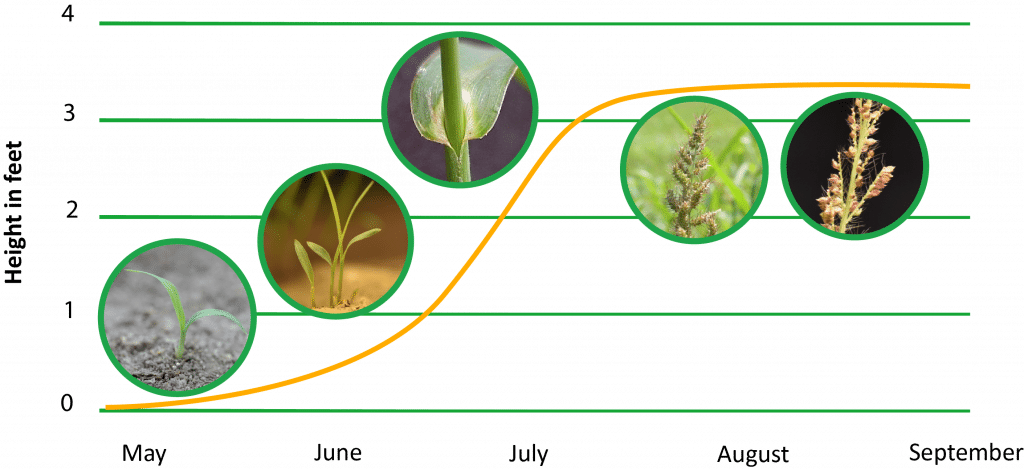
How does barnyardgrass spread?
Mature barnyardgrass seeds will usually fall and land within inches of the mother plant. The most common means of long-distance seed dispersal is the introduction of contaminated crop seed at planting. Other forms of barnyardgrass seed dispersal include water, as the lightweight seeds can remain afloat for four to five days. This characteristic can be important in rice production or in regions utilizing irrigation canals and surface drainage systems. Seed-eating birds can spread seeds as well. Barnyardgrass was one of the most common weed species found in the digestive systems of waterfowl surveyed along the Mississippi River flyway. Moving tillage or harvesting equipment within and between fields can also spread seed.
How many seeds can barnyardgrass produce and how long can those seeds survive?
Seed production can vary from 2,000 to 100,000 seeds per plant under field conditions. When barnyardgrass emerges simultaneously with corn, plants produce 14,400 to 34,600 seeds per m2, but when barnyardgrass emergence is delayed to the four-leaf corn stage, only 1,200 to 2,800 seeds are produced for the same area.
Most barnyardgrass seeds are viable for at least three years when buried in the soil, but a few seeds can persist for up to 13 years.
What other biological weaknesses does barnyardgrass have that can be targeted with management techniques?
As light exposure stimulates barnyardgrass germination, practices that shade the soil surface will help reduce seedling densities. These practices include cover crops, the rapid establishment of a dense crop canopy, and no-till cropping to expose weed seeds to predation and the elements. Conversely, burying seeds to depths of greater than four inches with tillage, can also suppress emergence.
Herbicide Resistance
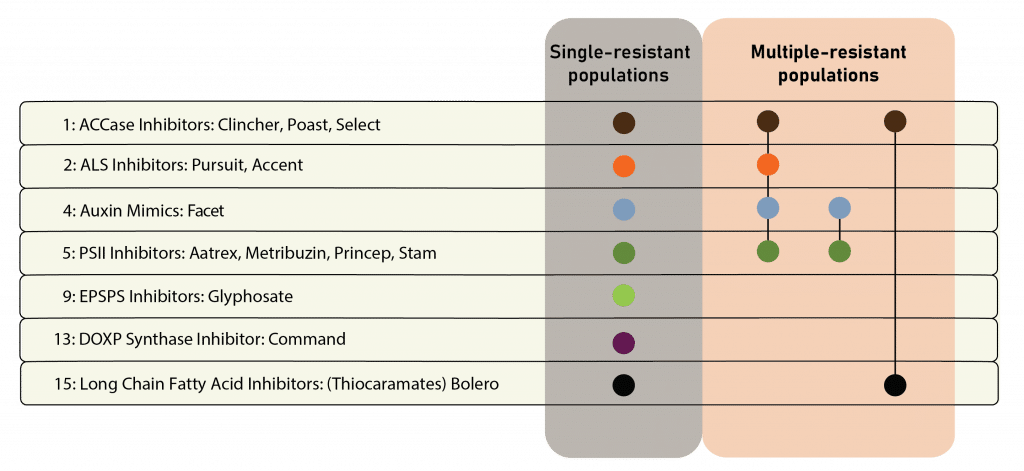
Contact your local extension office for details about resistance in your area and management options.
*Herbicide names listed are representative products that contain specific active ingredients. Last updated on: 03/10/2023
Integrated Weed Management Strategies for Control
Prevention is important to limit the spread of seeds, especially from suspected herbicide-resistant populations. Buying certified seed and cleaning all equipment that may harbor weed seeds are basic recommended prevention methods. If suspected herbicide-resistant plants are present at harvest, plan harvest operations to minimize the spread of seed within and between fields. The bulk of barnyardgrass emergence can be managed by starting with a clean field, adjusting planting timing, and the use of effective soil residual herbicides.
Scouting is important to ensure barnyardgrass is treated in a timely fashion. Post-treatment scouting is also necessary to evaluate the effectiveness of the application and determine if follow-up treatments are necessary. Since barnyardgrass is known to evolve herbicide resistance, it is important to identify escaped plants and prevent seeds from returning to the seedbank.
Cultural management tactics can take advantage of the later emergence timing of barnyardgrass (compared to many other problematic weeds).
All Crops: An early planting date can give cash crops a head start on barnyardgrass. Small grains, either fall- or spring-planted, are good rotational crops since a standing crop can significantly suppress barnyardgrass emergence.
Cultural practices that shade the soil will also improve control since light is critical for both the germination and establishment of barnyardgrass. Using narrow-row spacing or higher seeding rates can result in faster crop canopy closure and increased weed suppression. For example, soybean crops planted in 30-inch rows do not shade the soil as quickly as crops seeded at 15-inches or drilled. The narrow row spacing reduces barnyardgrass biomass and seed production potential.
Barnyardgrass responds to nitrogen applications with rapid growth. So, fertilizer applications should be timed to maximize crop development.
Rice
Barnyardgrass is an example of a weed taking on some of the crop’s attributes to avoid control (crop mimicry). As a result of thousands of years of intensive hand weeding in rice fields, barnyardgrass seedlings were able to survive by developing a very similar appearance to rice. In many cases barnyardgrass seedlings were mistaken for rice and unintentionally transplanted in rice paddies and thus escaped subsequent hand weeding.

Alternative methods of rice establishment, where feasible, can improve barnyardgrass control. Water-seeding of rice (common in CA), for example, is more effective in controlling barnyardgrass (and several other weeds), compared to the dry-seeded, delayed-flooded system commonly practiced in Southern U.S. rice production. In water-seeded systems, a flood depth of at least 5 inches is preferred. Flooding is an important weed control tool in organic rice systems as well.
Variations in flooding practices can also impact barnyardgrass emergence and density. Any delays in flood water establishment especially in the tail end fields may allow for barnyardgrass to emerge before flooding; once emerged, it has the ability to continue to grow in the flood water. Start a rice crop in a clean field regardless of the establishment system.
In fields heavily infested with barnyardgrass, delayed fertilizer applications can improve rice competitiveness and yields. Split nitrogen applications at 8 and 12 weeks after crop emergence can increase rice yield compared to an early set of applications at 3 and 8 weeks after emergence.
Mechanical methods such as tillage can play a role in barnyardgrass management. Barnyardgrass seed germination is favored by tillage, so practicing no-till can minimize seedling densities. No-till also exposes seeds to wet/dry cycles and greater temperature fluctuations that can reduce weed seed viability near the soil surface.
However, burying seeds with moldboard plowing is also an effective method of managing barnyardgrass seeds since they will not emerge when buried deeper than four inches. It is important that seeds remain buried for a few years, since buried seeds retain viability for a longer period than seeds closer to the soil surface. Frequent moldboard plowing results in returning viable seeds to the soil surface where they are likely to germinate and emerge. Likewise, shallow tilling, such as chisel plowing or discing can stimulate germination and favor weed emergence.
Given its relatively short germination period, barnyardgrass is a suitable species for stale seedbed practice. In this practice, tillage is used to prepare a seedbed and stimulate seedling emergence, encouraging the weed seeds to emerge and subsequently be controlled with light tillage or a herbicide application.
Barnyardgrass seeds are larger than most grass species, so they are able to germinate from a little deeper in the soil. Blind tillage with rotary hoeing or flex-tine weeding will destroy plants in the white-thread stage near the soil surface but this practice is not as effective on barnyardgrass as it is on small-seeded species. Interrow cultivation can be effective when cultivators are set to fully dislodge or bury seedlings. Since barnyardgrass has a relatively short emergence period, there is less risk of stimulating new emergence when cultivation is used.
Mowing is not as effective of a control method for barnyardgrass as it is for broadleaf species. Mowing must be done frequently to reduce viable seed production.
Using harvest weed seed control to manage barnyardgrass is another possible option, but it needs to occur as soon as the crops are ready for harvest for maximum effectiveness. Barnyardgrass shatters its seed soon after maturing, so a significant portion of the seed may no longer be on the plant for some late-harvested crops or during delayed harvest seasons. For example, two weeks after soybean maturity, 85% percent of barnyardgrass seeds were retained by plants, but at four weeks after soybean maturity, only 5% were retained.
Chemical control with multiple effective herbicide modes of action is a good approach to control barnyardgrass and mitigate selection pressure for herbicide resistance. It is important to know the status of herbicide resistance in your region before selecting specific herbicides. Barnyardgrass has evolved resistance to common herbicides (Herbicide Resistance chart above).
Rice
Clomazone (Group 13) is a very effective preemergence herbicide. Thiobencarb (Bolero) (Group 8) is applied delayed preemergence to the crop. Postemergence options include Group 1 [cyhalofop (Clincher)]; Group 2 [bispyribac (Regiment), penoxsulam (Grasp)]; Group 4 [quinclorac (numerous), florpyrauxifen (Loyant)]; or Group 5 [propanil (Stam)]. In herbicide-resistant rice varieties, imazethapyr/imazamox (Group 2) or quizalofop (Group 1) herbicides could be utilized for effective control.
Soybeans
Soybean fields should start clean, with either tillage or burndown herbicide products. Use a residual herbicide such as a Group 15 (S-metolachlor, acetochlor, pyroxasulfone, or dimethenamid), Group 13 (clomazone), or Group 3 (pendimethalin or trifluralin). Postemergence control can be achieved with an ACCase inhibitor (Group 1 such as fenoxaprop, quizalofop, or sethoxydim) at early growth stages. But for populations resistant to Groups 1 or 2, glyphosate (Group 9) or glufosinate (Group 10) are other options when used with the appropriate soybean herbicide-tolerance traits.
Corn and Grain Sorghum
Examples of effective soil-applied herbicides include Group 3 (pendimethalin); Group 5 (atrazine, simazine); or Group 15 (acetochlor, dimethenamid, pyroxasulfone, or S-metolachlor). Postemergence control options include Group 2 (nicosulfuron ); Group 9 (glyphosate); group 10 (glufosinate); or Group 27 (tembotrione or topramezone).
Barnyardgrass plants that have survived a postemergence herbicide and begin to regrow will need to be removed before they produce seed to ensure that herbicide-resistant populations do not develop.
Refer to your local extension’s weed management guide for effective herbicide options. For more information on chemical barnyardgrass management, visit:
growiwm.org/factsheets/barnyardgrass-management-in-soybeans/
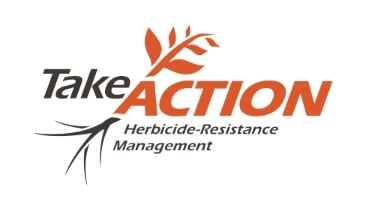
Biological control of barnyardgrass, such as microbial herbicides, has had limited success. Barnyardgrass seeds collected from digestive systems of waterfowl had up to 10% viability when collected in the intestines.
Similar Weed Species
Echinochloa colona (junglerice) is a similar weed species belonging to the same genus. Junglerice can be as abundant as barnyardgrass and is morphologically similar except that junglerice may often have distictive purple banding on the leaves and/or purple pigmentation in stem, leaf margins and inflorescences. Moreover, junglerice typically exhibits a spreading growth habit compared to the erect growth of barnyardgrass.
There are a wide variety of related Echinochola species such as E. orizoides (early watergrass) and E. oryzicola (late watergrass). They all have similar characteristics and may respond similarly to several of the control options.
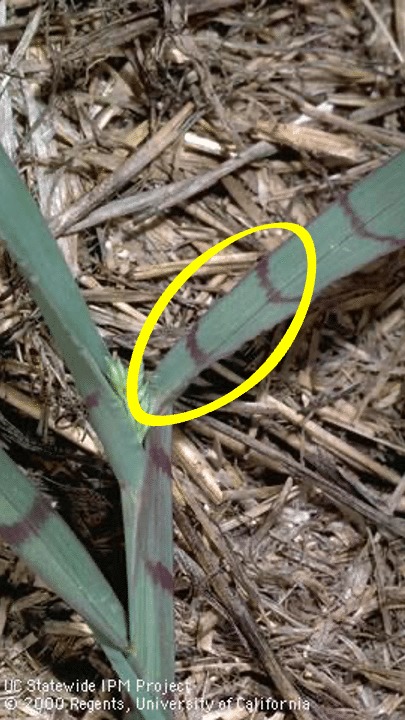
Echinochloa crus-galli var. frumentacea (“billion-dollar grass”, “Japanese millet”) is a similar species that was promoted as a forage crop but because of considerable drawbacks compared to traditional grass forages, it lost popularity. Japanese millet is often used today as a fast-growing cover crop.

Authors
Spencer Samuelson
Muthukumar Bagavathiannan
Editors
Mark VanGessel
Claudio Rubione
Michael Flessner
Emily Unglesbee
Victoria Ackroyd
Kreshnik Bejleri
Michael Flessner
Eugene Law
Lauren Lazaro
Steven Mirsky
Resources
Barber LT, Butts TR, Cunningham K, Selden G, Norsworthy JK, Burgos N, Bertucci M (2020) MP44 recommended chemicals for weed and brush control www.uaex.edu
Heap I (2020) The International Survey of Herbicide Resistant Weeds. www.weedscience.org Accessed on January 28, 2022
Knezevic SZ, Creech CF, Jhala AJ, Klein RN, Kruger GR, Proctor CA, Shea PA , Ogg CL, Thompson C, Lawrence N, Werle R (2017) Guide for weed, disease, and insect management in Nebraska. https://marketplace.unl.edu/extension/ec130.html
Mohler CL, Teasdale JR, DiTommaso A (2021) Barnyardgrass. Pages 145-148 in Mohler CL, Teasdale JR, DiTommaso A, eds. Manage Weeds On Your Farm: a guide to ecological strategies. USDA-SARE Handbook Series 16 https://www.sare.org/resources/manage-weeds-on-your-farm/
Pratt MS (n.d.) Utah State University Extension Range Plants of Utah: Barnyardgrass. Accessed online at: https://extension.usu.edu/rangeplants/grasses-and-grasslikes/barnyardgrass accessed on March 31, 2020
Take Action on weeds. Barnyardgrass https://iwilltakeaction.com/weed/barnyardgrass Accessed February 11, 2022
Citations
Barrett SCH (1983) Crop mimicry in weeds. Economic Botany 37:255-282 doi.org/10.1007/BF02858881
Barret SCH, Seaman DE (1980) The weed flora of Californian rice fields. Aquatic Botany 9:351-376 doi.org/10.1016/0304-3770(80)90036-4
Barrett SCH, BF Wilson (1983) Colonizing ability in the Echinochloa crus-galli complex (barnyardgrass). Canadian Journal of Botany 59:1844-1860 doi.org/10.1139/b83-063
Best KF, Looman J, Campbell JB (1971) Prairie Grasses. Agriculture Canada, Ottawa, Ontario Publishing 239, 1413 pp
Dawson JH, Bruns VF (1975) Longevity of barnyardgrass, green foxtail and yellow foxtail seeds in soil. Weed Science 23:437-440 doi.org/10.1017/S0043174500062834
Holm LG, Plucknett DL, Pancho JV, Herberger JP (1977) The World’s Worst Weeds: Distribution and Biology. University Press of Hawaii, Honolulu, Hawaii 609 pp
Holm LG, Plucknett DL, Pancho JV, Herberger JP (1979) A Geographical Atlas of World Weeds. John Wiley and Sons, New York 391 pp
Liebman M, Mohler CL Staver CP (2001) Ecological Management of Agricultural Weeds. New York: Cambridge University Press 532 pp
Maun MA, Barret SCH (1986) The biology of Canadian weeds #77 Echinochloa crus-galli (L.) Beauv. Canadian Journal of Plant Science 66:739-759 doi.org/10.4141/cjps86-093
MMitich LW (1990) Barnyardgrass. Weed Technology 4:918-920 doi.org/10.1017/S0890037X00026671
Smith RJ, Shaw WC (1966) Weeds And Their Control In Rice Production. Agricultural Research Service, US Department of Agriculture
Werle R, Sandell L, Buhler D, Hartzler R, Lindquist J (2014) Predicting emergence of 23 summer annual weed species. Weed Science 62:267-279 doi.org/10.1614/WS-D-13-00116.1
Reddy K (2001) Effects of cereal and legume cover crop residues on weeds, yield, and net return in soybean (Glycine max). Weed Technology 15:660-668 doi.org/10.1614/0890-037X(2001)015[0660:EOCALC]2.0.CO;2
Geng RM, Zhang JP, Yu LQ (2009) Helminthosporium gramineum Rabehn f.sp. Echinochloae conidia for biological control of barnyardgrass. Weed Science 57:554-561 doi.org/10.1614/WS-09-036.1
Schwartz-Lazaro L, Shergill L, Evans J, Bagavathiannan M, Beam S, Bish M, Mirsky S (2021) Seed-shattering phenology at soybean harvest of economically important weeds in multiple regions of the United States. Part 2: Grass species. Weed Science 69:104-110 doi.org/10.1017/wsc.2020.79
Motlagh MR (2011) Fusarium equiseti (Corda) Saccardo as biological control agent of barnyardgrass (Echinochloa crus-galli L.) in rice fields. Journal of Food, Agriculture & Environment 9:310-313
Gallery



